



Impact of Higher Corn Prices on Feed Costs
Corn and soybean meal prices have increased rapidly and may move higher over the next year. In the six weeks from mid-August to late-October Omaha corn prices increased $1.08/bushel and Central Illinois SBM increased $25.10/ton.Adjusting the Iowa State University Livestock Budgets to a 265 pound finished hog results in the feed usage estimates in Table 1. This simple analysis looks at the change in breakeven cost per cwt due to a change in corn and SBM prices. It ignores other feed cost like vitamins, minerals and processing that have not changed with the recent run up in feed prices.
Table 1. Estimated Change in Hog Feed Cost Due to a $1/bushel Increase in Corn Price and $25/Ton Increase in SBM Price
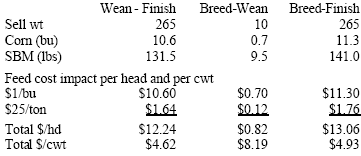
Table 2. Estimated Change in Breakeven Selling and Buying Price for Steer Calves and Yearlings Due to a $1/bushel Increase in Corn Prices
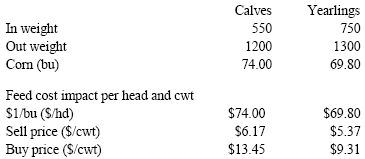
The estimated impact on feed cost of production for hogs is in the range of $4.50-$5.00 per hundred pounds of live weight or $6.08-$6.75 per hundred pounds of carcass weight on the finished hog. The weaned pig cost has increased less than $1 er head. Finishers buying weaned pigs or feeder pigs will try to bid down the price of pigs due to the rising cost of gain.
Cattle feeders also have rising feed cost. Most of the change is due to the change is corn prices, as protein supplement for cattle is less impacted by changes in SBM prices (Table 2). For cornhay rations the breakeven selling cost increases $5.00-$6.50 per cwt depending on the weight of the cattle and the ration. The price that feedlots can afford to pay for feeder cattle decreases, all else equal, due to the higher feed cost. Because the higher feed cost is spread over fewer pounds, the impact is larger on the feeder cattle price.
For both feeder cattle and feeder pigs the actual market price will depend on several factors, but given the higher cost of gain buyers will want to pay less for the feeder animal.
Distillers Grains and Solubles
While much of this fall’s corn price rally is due to short world wheat supplies, current and anticipated demand for corn from ethanol plants is also supporting prices. Ethanol production also results in a corn and SBM substitute, distillers grains and condensed distillers solubles. These products may contain only the distillers grain (DG), only the condensed distillers solubles (CDS), or more typically both distillers grains and solubles (DGS).The DG or DGS typically come in three forms: wet (approximately 35% dry matter), modified (approximately 50% dry matter), and dry (90% dry matter). While the actual nutrient analysis will differ by plant, these products are generally high in crude protein and fat. They can replace both corn and protein supplement in a ration.
In a grow-finish hog diet a common recommendation is to use DDGS for 10% of the ration. In a ton of feed 200 pounds of DDGS and 3 pounds of limestone will replace 160 pounds of corn, 38 pounds of SBM, and 5 pounds of DiCal Phosphate. With the current prices of $3/bu corn, $185/ton SBM and $95/ton DDGS this substitution will lower the cost of feed approximately $2.62 per ton. This amount of savings is approximately $.90-$1.00 per head compared to not using DDGS. A calculator to help evaluate the economics of substituting DDGS in hog rations is available at: http://www.ipic.iastate.edu/ethanol/ISUCalculator.xls
Feedlot cattle perform very well on ethanol coproducts, either wet or dry. In fact, cattle perform better on wet DGS than on DDGS and the products can be fed at much higher levels than in hog diets. The cost savings from feeding DGS to cattle depend on starting and ending weights and on the price of the product. The DGS will replace corn and approximately two-thirds of the commercial supplement. A vitamin and mineral supplement is still needed. At current prices of $3/bu corn and $35/ton modified DGS (approximately 50% dry matter), the cost savings per head is $40 and $65 per head when fed at the 20% and 40% of dry matter levels for 650 pounds of gain. Table 3 compares the impact on the breakeven purchase price for three levels of selling prices and three levels of modified DGS in the diet.
Feed cost and breakeven cost of production has increased for cattle and hog producers due to the higher corn prices. Using corn coproducts in the ration may offset some of the increased costs. Because DGS is a substitute for corn, its price will likely be bid higher along with corn prices, particularly for the dry product DDGS.
Table 3. Breakeven Buy Price for 650# Steers Finished at 1300# at Three Levels of Modified Distillers Grains and Solubles, $3 Corn $35 MGDS

September Milk Production Up 2%
The 23 reporting dairy states had a Sept 06 milk production increase of 2% according to the most recent USDA report. Milk per cow was up only 16 pounds but cow numbers were 79,000 higher than one year ago. Cow numbers did decline by 6000 compared to August. August milk production was unrevised.Milk cow numbers in Iowa were 3000 higher than last year but the same as last month. Milk per cow declined by 75 pounds leading to -3% total milk production. If Iowa cows had produced at the level as one year ago, total milk production would have risen by 15 million pounds or 4.7%. Iowa cheese production declined by 5.9% from one year ago and was -1.8% from the previous month.
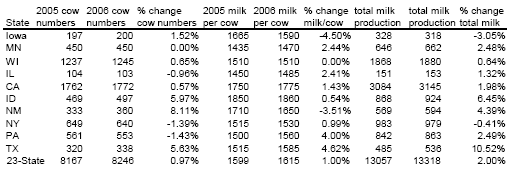
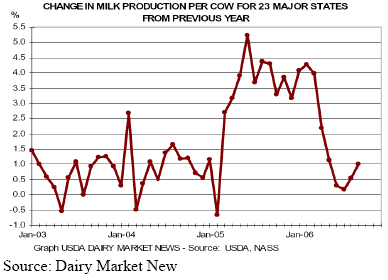
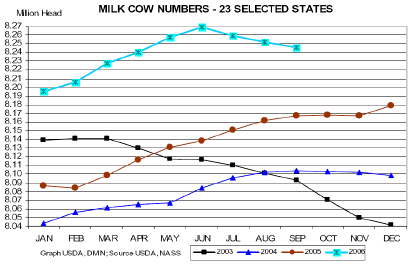
Demand & Dairy Products
US cheese production during Aug 06 was up 3.9% and was 2.5% higher than July. Nearly all of the year over year increase took place in the S Central and Western US. These areas include Texas, New Mexico, California and Idaho. New Mexico has recently opened a new large cheese plant and now has enough production entities for an individual monthly state report.
The Oct 20, 2006 Cold Storage Report indicated a 7% draw down of butter stocks but they are still 42% above a year ago. Total cheese stocks at the end of Sept 06 were 11% higher than one year ago and showed a 1% decline from September. Total cheese on hand Sept 30 was the highest since 2000.
USDA also revised the August cheese stock estimate. The previous estimate had shown inventories below Aug 05 but the new estimate put them at slightly above, 11 million pounds.
Aug 06 commercial disappearance showed a strong 3.2% gain. American-style cheese demand was only 0.9% following 7 months which had a total 6.2% demand increase. Other cheese demand was up 6.6% for Aug 06. Butter was up 7.3%. Fluid milk sales rose 1.3% for the June-Aug period compared to last year.
Whey demand has been very good and inventories very low. Whey price has increased about 8 cents per pound since last summer. NFDM stocks are below 2005 levels which were well below 2002, 2003 and 2004 levels. Much of the reason for low NFDM stocks can be explained by commercial exports, unsubsidized. NAFTA has led to Mexico buying 341 million pounds and displaced EU purchases. The weak US dollar has helped exports also and without DEIP incentives.
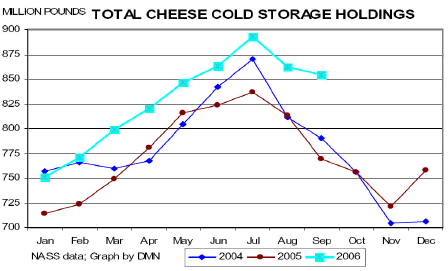
Analysis
Now, how do we interpret this market information? As mentioned last month, the dairy markets appear to be looking for direction. On Oct 30, barrel cheese settled 1 cent above blocks. Historically this has tended to indicate a move in cheese price is ready to occur. Barrel cheese prices are usually 3-4 cents below blocks. Two dairy economists have commented on a shortage of barrel cheese for processing needs. This cheese is needed for the food industry due to featuring in the fast food markets.
The market is also focusing on the US milk output increase, 1.6%, rather than the 23 dairy state rate of increase, a larger 2%. Milk cow numbers in the US are larger than one year ago, although month-to-month numbers have shown declines in recent months. The issue holding back higher increases in milk production is the weak rate of increase for milk per cow. CA showed a normal increase in milk per cow during September. But the number two state, WI, had flat production. NM had a 60 pound decline and Idaho only gained 10 pounds. Whether dairy producers are able to get back to normal milk per cow production gains is the question.
Recent ethanol and corn market impacts have brought that possibility into question. By now many dairy producers have feed prices for the coming several months mostly fixed since they grow feed or have contracted feed requirements. Also many US dairy farms have not experienced the full impact of low summer milk prices due to MILC payments. Those herds in the 250-400 or so cow range seem to be having the most financial challenges right now. These have run out of the MILC allotment.
During September, dairy cow slaughter was 206,400, down 10,100 from August but 16,000 more than one year ago. To get milk price direction, dairy markets will need to see real reduction in the US dairy herd. With higher milk prices anticipated, dairy farmers are not as likely to begin reducing cow numbers.
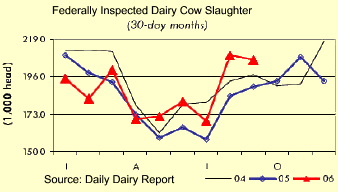
Grain Market Update
Since mid-September, the markets have traced out a highly unusual contra-cyclical market rally of about $1.15 in December corn and $1.26 in November soybean futures. In some areas, cash prices increased even more, due to basis strength. At this writing, corn and soybean prices have both turned downward very slightly. Strength in the grain markets began with wheat and was triggered by weather problems in several important wheat producing regions. That included the U.S. and Australia, and Iraq’s emergence as a major wheat importer, India’s shift from small exporter to substantial importer, tightening world stocks and uneasiness about newly planted wheat in parts of the southern plains. The wheat market peaked out in mid-October, after moving well above the $5 level. At this writing, Chicago December wheat is down $0.645 from its peak. Wheat prices, by creating incentives for reduced wheat feeding in international markets, had a strengthening influence on corn exports. Normally 4.0 to 4.5 billion bushels of wheat are fed in international markets. Corn prices continued to increase after wheat reached its peak, partly in response to the USDA October crop forecast showing U.S. production falling about a billion bushels below potential demand. Also, at this writing, trade sources expect the November 10 USDA crop estimate to show another decline in this year’s U.S. corn crop.Key Factors in the Corn Market
Corn supplies are not expected to be critically tight for this marketing year because carryover stocks can be used to fill the production-use gap. But next season is a different story. With stocks likely to drop slightly below abillion bushels (to a 4.1 week supply) by next August 31, next year’s production will need to approximately match demand, because carryover stocks will be approaching minimum trade needs. Since this year’s U.S. average corn yield is the second-highest on record, the supply-demand picture is strongly signaling a need for substantially more corn acres in 2007. Other supporting influences on corn prices also included a lagging harvest in the eastern Corn Belt, very good export sales, and historical crop report patterns hinting that crop estimates could decline a little more into the season-final estimate on January 12. Limited farmer marketings despite storage space shortages in some areas also helped to support the uptrend in prices. Indications of a need for at least 9 to 12 percent more corn acres in 2007 will keep prices volatile this winter and next spring. At current price levels, farmers may want to carefully evaluate their cash-flow needs for this fall and mid-to-late winter. Despite strong demand, prices will have some down-side risk at times in the next few months. Some ethanol plants in central Iowa at this writing were offering bids of $3.45 or higher per bushel for delivery from May through July.
After such a strong rally in both corn and soybean prices, the late October break in the market was not surprising. Current prices should be profitable for most corn producers, except in a few areas where yields were sharply below normal. Despite strong demand, prices will have some down-side risk at times in the next few months. The need for sharply increased corn acreage in 2007 offers a good chance that prices will show periods of strength several times during the winter and spring, but the probability of further price strength is less than 100%.
Soybean Developments
Current projections show ample soybean supplies for the September 1, 2006-August 31, 2007 marketing year. A significant increase in carryover stocks is projected again for next August 31, for the third consecutive year. These projections are based on the assumption of normal soybean yields in Brazil and Argentina’s spring 2007 harvests, along with a 5% to 7% decline in Brazil’s acreage. Our sources in Brazil indicate the sharp rise in soybean prices in the last 6 weeks is causing farmers there to re-think acreage plans, with a more likely reductiAon in acreage of 2-3 percent. The rise in prices also will encourage Brazilian farmers to apply inputs more generously than last year. Brazilian farmers have been disadvantaged by exchange rates in the last 3 years as well as the high costs of spraying for Asian soybean rust. Despite ample soybean supplies for this season, the need for substantially more corn acres next year is almost certain to reduce 2007 and 2008 U.S. soybean plantings. Our early longer-term projections (on our web site, www.econ.iastate.edu/faculty/wisner, right-hand column, just below “Balance Sheets” show U.S. soybean supplies (with normal yields) remaining adequate but somewhat tighter than this season in 2007-08, and tightening substantially in 2008-09. Recent Brazilian reports indicate planting conditions so far have been nearly ideal. Brazil’s soybean planting season extends from late September to early January, with peak plantings from late October to mid-December.
Export Sales Update
Both corn and soybean export sales so far this fall have been well above a year earlier. For corn, the cumulative shipments and sales are the largest in several years, as shown below. Strength in corn exports reflects a sharp reduction in corn yields in Argentina and South Africa in last spring’s harvest, as well as the reduction in foreign wheat feeding. Soybean export sales are sharply above a year earlier, when exports were held back by widespread concern about bird flu in major foreign poultry feeding areas. However, soybean export sales are well below the levels of three years ago.

Harvest Progress Still Lagging in East
The corn crop in the 18 states that produce most of the nation’s corn was reported to be 68% completed as of October 29. That was well below last year’s 78% and slightly below the 5-year average of 71%. As shown below, harvesting lagged most in Michigan and Ohio with 32% and 34% completed, followed byWisconsin at 40% and Indiana at 49% complete. Iowa’s corn crop was reported to be 68% complete by October 29. That was very slightly behind the 5-year average of 68%. Nationally, 83% of the U.S. soybean crop was reported harvested. That was down slightly from the 5-year average of 85%. Key Indicators to Watch
Corn and soybean prices will be potentially quite sensitive to USDA’s November 10 Crop Production and Supply-Demand reports. Based on past history, the grain trade anticipates a modest decline in the corn production estimate. Past history suggests the soybean production estimate could increase slightly. Other key indicators will include Export Sales reports, South American planting progress, and U.S. harvest progress.
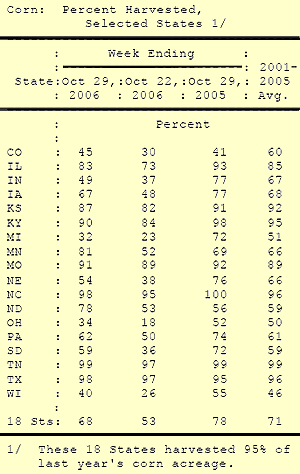
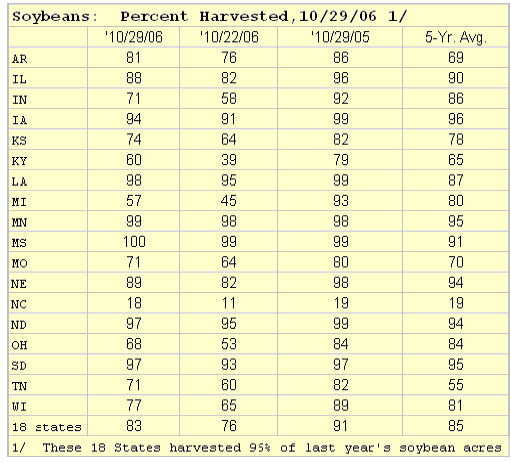
October 2006



